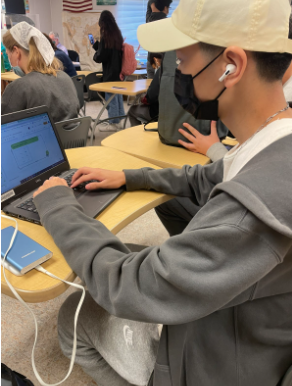Dress codes affect student learning

Senior Samuel Park works on an assignment wearing a newly allowed hat on Oct 20.
November 26, 2021
A student gets pulled out of class for wearing a cropped shirt, and because they do not have a set of clothes to change into, they are sent home and miss the rest of the school day. Having missed a lesson and needing to make up work, the student may fall behind.
According to Find Law, the first dress code law was established after the case Tinker vs. Des Moines to ensure a lack of distractions and to allow administrators to monitor and limit students’ individualism in order to foster a proper learning environment. However, according to VOX, after protests from both students and parents, public schools across the country have started to take a more lenient approach to dress codes over the last few years.
“I think because we all have different standards of what appropriate attire is, it’s very hard to set a universal [dress code],” assistant principal Amy Parmentier said.
According to Fresno Pacific University, one reason for stricter dress codes is to create an environment similar to that of a workplace. However, their research found that heavy monitoring on students’ clothing promotes conformity rather than adaptability, creativity and critical thinking, which are traits that are more desirable in both an educational and occupational setting.
“Students’ [clothing] will only affect learning if they are dressed in an extreme way,” senior Alyse Madsen said. “Strict dress codes infringe on a students self-expression and make for a dull environment with little creativity.”
In accordance to Title IX, a civil rights law that prohibits sex-based discimination in school or any school-sponsored events, dress codes are not allowed to have a gender bias. Still, an interview conducted by Time Magazine revealed that female students often feel unfairly targeted by dress codes, stating that their bodies should not be seen as a distraction in an academic setting.
“I’ve heard and seen so many women get dress coded for wearing short shorts, but guys wear shorts that are the same length, sometimes even shorter, and no one seems to have a problem with that,” senior Samuel Park said. “If a guy is distracted by a girl’s exposed shoulders, it’s more of the guy’s fault for finding an excuse to be distracted than it is the girl just wearing what she wants because it’s hot outside or stylish.”
A study conducted by Education Partnership Incorporated found that while some researchers reported a positive correlation between stricter dress codes and academic achievements, others have found no correlation between the two. In addition, their researchers warn of the chances of limiting students freedom of expression.
“Dress codes are necessary but at the most minimal level,” Park said. “I think people should be able to express themselves through clothing because it’s a big part of our appearance and plays a big role in our confidence as well.”



Mia • Apr 17, 2023 at 5:45 pm
I do not like dress codes! I not allowed to wear tank tops!
Jael • Apr 17, 2023 at 5:44 pm
It’s not fair how people pick on the females a lot but then the males not that much.
Dann A Shults • Mar 9, 2023 at 12:34 pm
This is such an article of all time
gracie • Mar 3, 2023 at 1:05 pm
I don’t dress codes are very fare either.
Mia • Apr 17, 2023 at 5:47 pm
Yeah they aren’t! The boys in my school are allowed to wear tank tops but the girls can’t!
orcutt • Jan 20, 2023 at 10:43 am
just from the picture i think it will be very boreing
Casey • Oct 14, 2022 at 9:13 am
This is my thoughts before me reading. I don’t think it matter abt dress code
Faezu • Sep 19, 2022 at 1:21 pm
Hi I want to learn cloth coad
Carl Azus • Sep 26, 2022 at 2:23 pm
I agree.